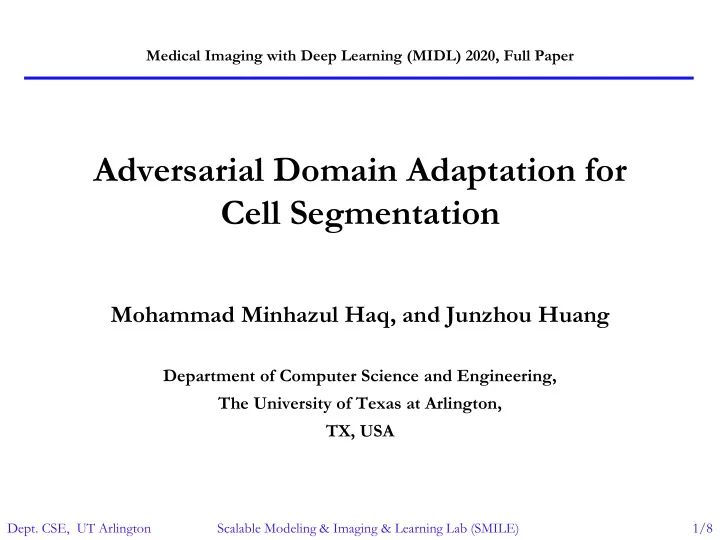

Medical Imaging with Deep Learning (MIDL) 2020, Full Paper Adversarial Domain Adaptation for Cell Segmentation Mohammad Minhazul Haq, and Junzhou Huang Department of Computer Science and Engineering, The University of Texas at Arlington, TX, USA Dept. CSE, UT Arlington Scalable Modeling & Imaging & Learning Lab (SMILE) 1/8
Introduction In Cell Segmentation problem, we want to segment the cells • (nuclei) from the background Figure: Cell Segmentation To successfully train a cell segmentation network in fully- • supervised manner, we need ground-truth annotations of a dataset However, such annotated dataset is highly unavailable because • labeling process is tedious – it requires domain experts (pathologists) – it is expensive – Dept. CSE, UT Arlington Scalable Modeling & Imaging & Learning Lab (SMILE) 2/8
Proposed solution We observed that, images from different cell datasets/organs • exhibit dissimilarity while their corresponding segmentation ground-truth labels are quite similar Figure: Motivation behind the proposed solution Let’s assume, we have two datasets from two different organs • one with annotations (source domain), another without annotation (target – domain) We apply a technique called Domain Adaptation with help of • the annotated dataset Dept. CSE, UT Arlington Scalable Modeling & Imaging & Learning Lab (SMILE) 3/8
Methodology Figure: Complete architecture of CellSegUDA • Segmentation network takes input images, and produces segmentation predictions Discriminator distinguishes between source-domain and target-domain prediction • Decoder ensures that target domain predictions spatially correspond to target domain • images Dept. CSE, UT Arlington Scalable Modeling & Imaging & Learning Lab (SMILE) 4/8
Experiments Datasets • Dataset-1: KIRC (Kidney Renal Clear cell carcinoma) – - 486 patches of size 400x400 Dataset-2: TNBC (Triple Negative Breast Cancer) – - 50 patches of size 512x512 Experimental setups of CellSegUDA (unsupervised domain • adaptation) Experiment 1 (KIRC → TNBC) Experiment 2 (TNBC → KIRC) 100% of KIRC (with labels) + 100% of TNBC (with labels) + Training 80% of TNBC (w/o labels) 80% of KIRC (w/o labels) Validation 10% of TNBC (with labels) 10% of KIRC (with labels) Testing 10% of TNBC 10% of KIRC For CellSegSSDA (semi-supervised domain adaptation), we utilize • incremental percentage (10%, 25%, 50% and 75%) of target dataset labels while training Dept. CSE, UT Arlington Scalable Modeling & Imaging & Learning Lab (SMILE) 5/8
Experimental results Experiment 1 Experiment 2 (KIRC → TNBC) (TNBC → KIRC) Method IoU% Dice score IoU% Dice score U-Net (source-trained) [1] 52.66 0.6875 54.82 0.7056 DA-ADV [2] 54.93 0.7079 55.43 0.7107 CellSegUDA w/o recons 56.56 0.72 56.91 0.7224 CellSegUDA 59.02 0.7394 57.09 0.7242 U-Net (source 100% + target 10%) 60.74 0.7534 56.89 0.7194 CellSegSSDA (source 100% + target 10%) 60.96 0.7557 58.81 0.7377 U-Net (source 100% + target 25%) 61.67 0.7607 59.32 0.7405 CellSegSSDA (source 100% + target 25%) 62.94 0.771 59.73 0.7443 U-Net (source 100% + target 50%) 56.73 0.7208 59.95 0.7464 CellSegSSDA (source 100% + target 50%) 63.59 0.7748 60.32 0.7494 U-Net (source 100% + target 75%) 59.06 0.7394 61.63 0.7592 CellSegSSDA (source 100% + target 75%) 64.96 0.7862 61.01 0.7541 U-Net (target-trained) 66.57 0.7985 62.04 0.7621 [1] U-net: Convolutional networks for biomedical image segmentation, MICCAI 2015 [2] Unsupervised domain adaptation for automatic estimation of cardiothoracic ratio, MICCAI 2018 Dept. CSE, UT Arlington Scalable Modeling & Imaging & Learning Lab (SMILE) 6/8
Visualizations Figure: Visualization of segmentation for KIRC → TNBC. Blue arrows indicate missing cells of previous methods, and Yellow arrows indicate false positives which are removed by following method. Dept. CSE, UT Arlington Scalable Modeling & Imaging & Learning Lab (SMILE) 7/8
Conclusion A novel unsupervised domain adaptation framework is proposed • for segmenting cells in unannotated datasets utilizing adversarial learning – domain adaptation in output space – decoder network – Then, it is extended to semi-supervised domain adaptation • considering a few annotations available from the target domain – In both cases, significant improvement is achieved as compared • with the baseline methods Have questions? • please contact at mohammadminhazu.haq@mavs.uta.edu – Dept. CSE, UT Arlington Scalable Modeling & Imaging & Learning Lab (SMILE) 8/8
Recommend
More recommend